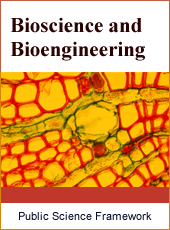Bioscience and Bioengineering
Articles Information
Bioscience and Bioengineering, Vol.1, No.3, Aug. 2015, Pub. Date: Jul. 23, 2015
Estimation of Bio-kinetic Coefficients
Pages: 90-93 Views: 4713 Downloads: 1367
[01]
M. Jawad A., Department of Environmental Sciences, University of Haripur, District Haripur, Pakistan.
[02]
Abdullah K., Department of Environmental Sciences, University of Haripur, District Haripur, Pakistan.
[03]
Arshad A., Civil Engineering Wing, MCE, National University of Sciences and Technology, Islamabad, Pakistan.
[04]
Ghayas K., Department of Environmental Sciences, University of Haripur, District Haripur, Pakistan.
[05]
Naveed A., Department of Environmental Sciences, University of Haripur, District Haripur, Pakistan.
[06]
H. Shahab, Civil Engineering Wing, MCE, National University of Sciences and Technology, Islamabad, Pakistan.
[07]
H. Umaira S., Department of Environmental Sciences, Northern University, Nowshera, Pakistan.
The UASB reactor was operated at optimum Organic Loading Rate (OLR) of 0.60kg-COD/m3-day, with Hydraulic Detention Time (HDT) of 2.67-1.58hrs during the study, using actual effluent of the textile mill. The mean values of K, Ks, Kd, Y and µmax obtained while operating the UASB reactor at optimum conditions were determine to be 0.31d-1, 77.5mg/L, 0.32d-1, 0.23 and 0.26d-1, respectively. The calculated concentration of effluent substrate, HDT, effluent biomass and biomass yield were found to be 10.95mg/L, 4.8hrs, 1632mg/L and 0.28, respectively. For a textile effluent of 1000GPD, the computed volume of the reactor was found to be 12.50m3. And the determined biomass per was estimated to be 2.12kg/day. Hence, the values of coefficients K, Ks, Kd, Y and µmax obtained will be used to validate the model and to predict treatment efficiency, and predict organic loading methane productivity of any UASB reactor treating textile effluent.
UASB, Bio-kinetics, Optimum Usage, OLR
[01]
Vieira, S.M.M., (1988). Anaerobic treatment of domestic sewage in Brazil. Research results and full-scale experience. In: Hall, E.R., Hobson, P.N. (Eds.). Proceedings of Fifth International Symposium on Anaerobic Digestion, Bologna, Italy, pp. 185–196.
[02]
Scholz-Muramatsu, H., Neumann, A., MeBmer, M., Moore, E., Diekert, G., (1995). Isolation and characterization of Dehalospirillum mutivorans gen. non. sp. nov, a tetrachloroethene utilizing, strictly anaerobic bacterium. Arch. Microbiol. 163: 48-56.
[03]
Ali, M. Sreekrishnan, and T.R. (2001). Anaerobic toxicity from pulp and paper mill effluents: A review, Adv. Environ. Res., 5:175-196.
[04]
Bryant, M.P. (1979). Microbial methane production – theoretical aspects. J. Animal Sci., 48: 193-201.
[05]
Arshad, A., Shahid, I., Anwar, U.H.C., Baig, M.N., Khan, S. and Shakir, K. (2014). The wastes utility in concrete. International Journal of Environmental Research, 8(4), 1323-1328
[06]
Bambang, S. (2014). Toward green concrete for better sustainable environment. Procedia Engineering, 95, 305-320.
[07]
Driessen, W.J.B.M., Tielbaard, M.H., Vereijken, T.L.F.M. (1994). Experiences on anaerobic treatment of distillery effluent with the UASB process. Water Science Technology 30:12.
[08]
Fitzsimons, R. Ek, M., Eriksson, K.E.L., (1990). Anaerobic dechlorination/degradation of chlorinated organic compounds of different molecular masses in bleach plant effluent. Environ. Sci. technol. 29: 1744-1748.
[09]
Bhatti, Z.I. (1995). Studies on the biological treatment of methanolic waste in UASB reactor, PhD Thesis, Osaka University, Japan.
[10]
APHA, AWWA, and WEF, 1995, Standard Methods for the examination of water and wastewater, 19th edition, Washington DC
[11]
Eckenfelder, W.W. Jr (2nd Ed) 1989: Industrial water pollution control, Mc Graw Hill Book Company.

ISSN Print: 2381-7690
ISSN Online: 2381-7704
Current Issue:
Vol. 6, Issue 3, September Submit a Manuscript Join Editorial Board Join Reviewer Team
ISSN Online: 2381-7704
Current Issue:
Vol. 6, Issue 3, September Submit a Manuscript Join Editorial Board Join Reviewer Team
| About This Journal |
| All Issues |
| Open Access |
| Indexing |
| Payment Information |
| Author Guidelines |
| Review Process |
| Publication Ethics |
| Editorial Board |
| Peer Reviewers |


